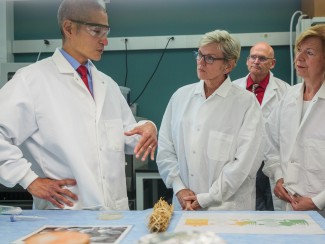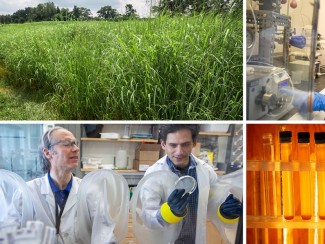On July 22, more than 80 congressional staff members gathered at the Rayburn House Office Building in Washington, DC for a Q&A-style briefing intended to update the House Science and National Labs Caucus on the latest progress of the Department of Energy (DOE) Bioenergy Research Centers (BRCs).
The event represented districts from across the country and featured leaders from three of the nation's top bioenergy research institutions, including Great Lakes Bioenergy Research Center Director Tim Donohue of the Wisconsin Energy Institute (WEI). Donohue joined Joint BioEnergy Institute CEO Jay Keasling as well as Oak Ridge National Laboratory Associate Director and former BioEnergy Science Center Director Martin Keller in the nation's capital.
General Motors executive Candace Wheeler moderated the robust conversation, fielding questions from congressional staff members on topics ranging from science and technology to policies supporting the development of advanced biofuels.
In response to Wheeler's opening prompt on the need for advanced biofuels, the leaders agreed that the transportation sector's dependence on petroleum continues to be a global concern. They emphasized that in addition to ameliorating fossil fuel dependence, the development of 'green' energy alternatives like cellulosic biofuels provides additional environmental and economic benefits in the form of renewable replacements for other petroleum-based chemicals.
Members of the congressional audience asked the leaders whether there is an ideal biofuel they are aiming for in their research, and what the major barriers are to the large-scale deployment of biofuel technologies. The leaders said that all bioenergy options are open to exploration, and that the BRCs' basic science approach provides the innovation knowledgebase needed to advance the multiple technological solutions that are likely to be required to support a renewable energy infrastructure.
A stated challenge facing widespread commercial biofuel production is the development of efficient biomass-to-fuel conversion technologies. Citing examples of biorefinery development in the American Midwest and a start-up company in South America, Keasling said that industry investments in biorefinery capacity are progressing well, but they have not yet achieved the scale required for biofuels to become fully-fledged alternatives to petroleum.
According to Keasling, approximately 30-50 miles of continuous land are needed to grow enough biomass to support a single biorefinery-an estimate that elicited questions related to ethical water and land use policy, and the direct local economic and employment impacts of cellulosic biofuels. Donohue and Keller referenced research investigating the bioenergy potential of marginal lands-those that are unsuitable for growing food crops-that could be used to support non-edible cellulosic feedstocks like grasses and woody plants.
In addition to providing a unique opportunity for all three leaders to come together and showcase current initiatives and future research directions, the notably well-attended event exemplified the growing dialogue among the BRCs, WEI and legislators in DC.




